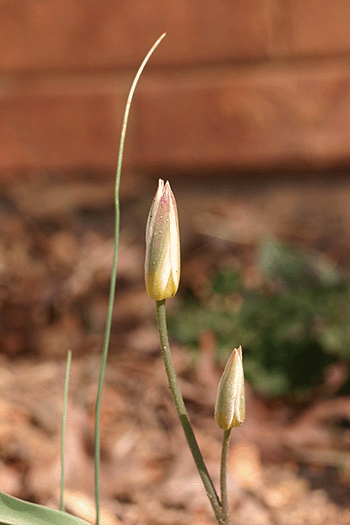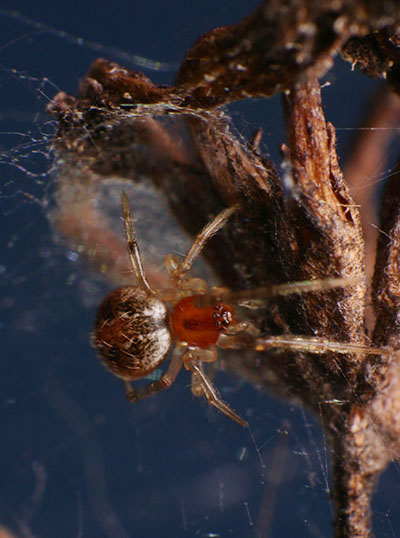 About a week ago, I noticed that another of The Girlfriend’s Younger Sprog’s flowers was of the type that opens each morning (when the conditions are right,) and started planning to try again to capture this. Naturally, the weather went to yuck for the next few days after that, but I watched for the promise of a clear warm morning and got set up early when it arrived. I learned that the flower (whatever it is – I’m yielding to laziness again by not looking it up) responds more to temperature than sunlight, and defiantly stayed closed and motionless for the 90 minutes and fifteen frames that the camera was dutifully snapping away before the day warmed sufficiently. After I packed up, of course, the flower bloomed.
About a week ago, I noticed that another of The Girlfriend’s Younger Sprog’s flowers was of the type that opens each morning (when the conditions are right,) and started planning to try again to capture this. Naturally, the weather went to yuck for the next few days after that, but I watched for the promise of a clear warm morning and got set up early when it arrived. I learned that the flower (whatever it is – I’m yielding to laziness again by not looking it up) responds more to temperature than sunlight, and defiantly stayed closed and motionless for the 90 minutes and fifteen frames that the camera was dutifully snapping away before the day warmed sufficiently. After I packed up, of course, the flower bloomed.
So, as seen here, I tried again the next day and was a bit more successful. Scattered thin clouds made the light highly variable, most noticeable at the very end when the final frame is shot under haze, lowering the contrast and making it seem as if I’d altered the photo (I mean, beyond the resizing and format changes to make an animated gif [pronounced “fig”] in the first place.) This time I went with auto-exposure, but under-exposed a stop to keep the flower from getting bleached out, knowing the meter was reading more of the background than the flower itself – I should probably have gone for only 2/3 of a stop under, though. While a gentle breeze may have been at play too, the motion of the flower is not my doing at all, and why it was waving around is beyond me – the sun certainly did not move that far to support the idea that the bloom was following it. Yes, I could have been better at leveling the camera when I set up, but at least I kept the shadow of the tripod out of the pic this time.
Okay, okay, I stopped being lazy – I think these are Tulipa turkestanica, or Turkestan tulips, but that’s just a tentative identification (I wasn’t the one who planted these.) But I do have a positive ID on this next pic.

You have to appreciate the texture of these leaves. This is a Tulipa greigii, or red riding hood tulip. The leaves spread about 10cm, so the central blob of water is about 4cm, or 1.5 inches – I’ve never seen a surface so repellant to water, and I’d love to view it close enough for detail, but that would take a microscope I think. This isn’t the first time I’ve photographed the peculiar edge effect either, where it seems the only place water will actually adhere, and I can’t tell you anything more about it. I’m a photographer, not a botanist; I can tell you why the light looks the way it does and what f-stop was used (f16,) but the nature of leaves has to come from someone else. Or you can buy a print and I’ll look it up for you.
 Today was apparently a great day for the arachnids to venture out. At times, the light was just right and the yard could be seen crossed by numerous strands of web from the spiders ballooning to new locations, and I actually had two different species suddenly appear on my arms – dog knows how many might have landed on my shirt where I couldn’t feel them (or my hair – I said that just to creep you out, even though it’s as likely as anyplace else.) The butterfly bush, sprouting just two new leaves of the season, was heavily rigged with lines from this little spud, some species of Theridiidae I believe. Likely the same species found here, on a plant not a dozen meters away – probably not one of the ones pictured in that post, but quite possibly a relative. I found all the webbing and started looking for the responsible party, suspecting it was one of last year’s newborn green lynx spiders, and the increasing number of web strands and a tangle of protective canopy pointed out my tiny subject. That’s one of those tricks if you’re looking for arachnid subjects: the webbing is densest in the high-traffic areas. You can see the shelter out of focus behind the spider – this is shot aiming almost straight up. For scale, I can tell you that this one is even smaller than the green lynx spiderlings (Peucetia viridans,) and I can provide a photo of one of those on my thumb. We’re talking tiny here.
Today was apparently a great day for the arachnids to venture out. At times, the light was just right and the yard could be seen crossed by numerous strands of web from the spiders ballooning to new locations, and I actually had two different species suddenly appear on my arms – dog knows how many might have landed on my shirt where I couldn’t feel them (or my hair – I said that just to creep you out, even though it’s as likely as anyplace else.) The butterfly bush, sprouting just two new leaves of the season, was heavily rigged with lines from this little spud, some species of Theridiidae I believe. Likely the same species found here, on a plant not a dozen meters away – probably not one of the ones pictured in that post, but quite possibly a relative. I found all the webbing and started looking for the responsible party, suspecting it was one of last year’s newborn green lynx spiders, and the increasing number of web strands and a tangle of protective canopy pointed out my tiny subject. That’s one of those tricks if you’re looking for arachnid subjects: the webbing is densest in the high-traffic areas. You can see the shelter out of focus behind the spider – this is shot aiming almost straight up. For scale, I can tell you that this one is even smaller than the green lynx spiderlings (Peucetia viridans,) and I can provide a photo of one of those on my thumb. We’re talking tiny here.

The biggest difference is, the lynx spider will get significantly bigger while the Theridiidae won’t – it might even be an adult. Well, okay, that’s probably not the biggest difference from an entomological standpoint, so let’s just say that this scale comparison isn’t going to last for long. The lynx spider may achieve a body length slightly longer than the first joint of my thumb, big enough to be ‘skeery’ (due to the prevalence of arachnophobia, this should not be considered a scientific description, since the word has been applied to widely disparate sizes of spiders.)
The rosemary bush that several of the lynx spiders have made their home, at least for now, also plays host to several specimens of sheetweb spider. These make a horizontal, very dense base web, often pulled down into a rough bowl shape, and a tall enclosing structure above, less dense and distinctly triangular in shape. When coated in early morning dew, they put me in mind of a sailing ship, with the base web forming the hull of the boat and the upper structure serving as the rigging. Often these webs are most easily spotted in dewy conditions or during a misty rain, and several times the snows of the season pointed out how many of these spiders were actually living on the bush. Yesterday and today I got a few images of one, proving that they have already started feeding, in this case on an eentsy little leafhopper. I’m fairly certain this is a filmy dome spider, Neriene radiata – probably twice the size of the lynx spiders right now, but also unlikely to get a lot larger.

What I’m pleased about capturing, in both images, is a particular detail of the web. The haphazard nature of the sheet is clearly visible, as are some of the anchor lines that draw the sheet taut and downwards, providing the bowl/hull shape and coincidentally illustrating the warp of spacetime at a black hole. If you didn’t get that, some day you will…
If you think the sheet looks too dense to allow the spider to slip through to the other side, you might be right. I just looked closely at the original image, the top one of the composite above, and I’m almost positive the leafhopper sits above the sheet while the spider sits below, reaching through the surface to feed. If this is typical, it implies that the spider does not bother wrapping its prey but counts on the venom to immobilize it instead. I’m going to have to keep a close eye on these now to see if this repeats, but that’s going to be a little tricky – the webbing defies easy depth-perception and it’s hard to tell which side anything is on, while the locations that the spiders have chosen for their lairs, purposefully I imagine, do not allow a wide range of camera positions. We’ll see what happens.




















































